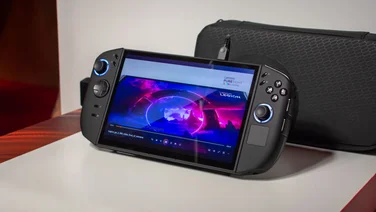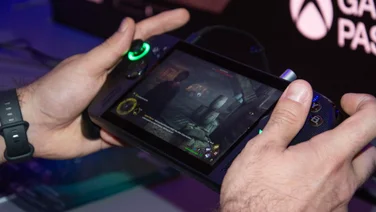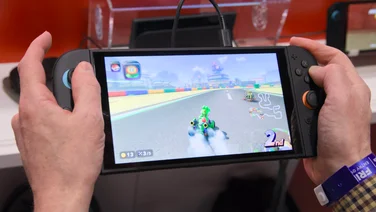To help us provide you with free impartial advice, we may earn a commission if you buy through links on our site. Learn more

- Sharper, more fit-forgiving lenses
- Dramatically more powerful
- Can be used standalone or for PSVR
- VR fans will want a better strap
- Raised black levels
- Less approachable pricing than the Quest 2
The Meta Quest 3 is the do-it-all VR headset for the masses. If you want a standalone headset, you got it. Want something for high-end VR gaming connected to a PC? No problem.
You set the boundaries of your room in a minute and can then wander about in VR. While most games require the bundled motion controllers, the fidelity with which the Meta 3 can model your hands in a 3D space is uncanny. It improves on the hit, 18-million selling Meta Quest 2 with colour passthrough, a lot more power and noticeably improved image quality.
This is a significant upgrade, but right now, the Meta Quest 3 isn’t necessarily the easiest of recommendations for Quest 2 owners. Why? Some of the best bits aren’t used that much in third-party software yet. And market forces say they may not be for some time.
Can developers afford to freeze out all those Quest 2 owners just to make greater use of colour passthrough? Ask us again in 18 months. There’s still life in the Quest 2 but if you want the best low-fuss mainstream headset around or are hankering for a quality upgrade, the Meta Quest 3 provides it.
Meta Quest 3 review: What you need to know
Everything you need to get going with a Meta Quest 3 is included in the box. That’s the headset and strap, charger and cable, plus the two controllers. Just add a spot of Wi-Fi and you’re away.
There’s no need for an expensive PC or console because this headset runs a modified version of Android and its own software. Dig down deep enough and some of the Meta Quest 3’s insides start to look just like those of a phone.

However, unlike the PSVR 2, you can also use the Meta Quest 3 with a PC if you want to, which is one of the major strengths of the platform. While Meta’s store has loads of great content, you still need a PC to try VR experiences like Half-life: Alyx. This connection can be made wirelessly or with a cable.
All of this stands for the Meta Quest 2 as well, though, so the crux of whether the Quest 3 is worth buying is found elsewhere.
READ NEXT: Best VR headsets
Meta Quest 3 review: Price and competition
The Meta Quest 3 represents a jump up in price but less of one that you might imagine.
While the Quest 2 made great strides in making VR a bit more mainstream thanks to its £299 price, its 2018 predecessor, the original Quest, sold for £399. That’s not too far off the £479 of the Quest 3, which has twice the amount of storage in its entry-level version.
There are two models, just like last time, and the only difference is the amount of storage they have. You’ll pay £480 for the 128GB version or £620 for the 512GB version.

An extra £140 for 384GB space in an era of cheap solid-state storage? It is a little steep, but the 512GB version does include a six-month trial of Quest Plus VR, which grants access to two games a month and usually costs £7.99/mth.
Both Quest 3 headsets also include the highly anticipated Asgard’s Wrath 2 if you purchase before February 27, 2024. It’s listed at £45 at the time of review.
The Pico 4 is its key rival, a £349 standalone headset that offers pancake lenses and colour passthrough on a budget; this model came out in October 2022. However, the Quest 3 is far more powerful and has far better passthrough. If you mostly play PC VR games, consider getting the Pico 4; and a year on, you can find it at an even better price.
Sony’s PSVR2 belongs in a completely different category as it requires a PS5 to use. As does the Meta Quest Pro, which costs £999 and only has minor benefits for the average VR dabbler. The Vive Pro 2 is also in a completely different price league, and is not a standalone headset.
Meta Quest 3 review: Design and features
A quick look around the Meta Quest 3 acts as a tour of some of its key new features, and also shows this is an arguably worse-looking headset than the Quest 2. It’s just a touch busier. Three camera housing blobs sit around the front which are home to the new dual colour cameras for passthrough, as well as a depth sensor.
Put the Quest 3 on and you’re able to see your room in colour, not just in black and white like the Quest 2. Meta explores this in a pre-installed mini-game called First Encounters, in which furry aliens break through your living room, and you can blast through its walls with your laser gun.

The black and white passthrough of the Quest 2 feels like a way to help you avoid crashing into your TV. Here it has the potential to become part of the proper experience, which is the promise of mixed reality. It’s very cool to experience.
However, play in the evening, in your moderately lit living room, and the passthrough picture will look quite fuzzy and noisy. This is simply the reality of low-light video in action with mobile-phone-grade camera tech. And in a side-by-side comparison with the Meta Quest 2, that older headset has better ultra-low light passthrough visibility. Black and white cameras are naturally more sensitive thanks to their lack of a colour filter.
Want true passthrough fidelity? You need the Apple Vision Pro, due next year at around seven times the cost.
We also don’t get a world-changing upgrade in how the Quest 3 feels to wear. It still has a basic elastic strap, though this can be upgraded with the expensive £69 Meta Quest Elite strap, or a third-party alternative.

This strap is not ideal for long sessions, and the Quest 3 is actually slightly heavier than its predecessor at 515g (up from 503g). I still often find a pressure build-up on my brow if I’m not careful about the fit. However, the strap design is at least marginally better thanks to a “Y” shaped section which removes the headset’s front-heavy feel. There are other major usability changes too. The control to change the IPD (inter-pupillary distance) is easy to alter while the headset is on. And there’s an on-screen indicator of the current value, which you may have access to if you’ve ever had an eye test.
Additional cameras around the sides of the headset increase the area in which the Quest 3 can track the controllers and your hands. If you’re new to Quest VR, you’ll see the all-in-one motion controllers and gamepads lack the rings you may have seen on the Quest 2. Controller-free hand tracking is fantastic here, too, with an uncannily lifelike representation of the articulation of your finger joints, and even the shape and size of your hands.

It even has a best guess at what your hands are doing while obscured by objects, such as a coffee mug. You can reach into the air to select menu items in the Meta Quest 3 interface, while headset vibration provides some tactile feedback to signify a press.
Opening up a game will almost invariably ask you to switch to the controllers, but this hand-tracking feels like a real technical achievement regardless. Does it still need to be improved? Yes, as the navigation gestures can feel flaky at times.
Meta Quest 3 review: Display
The display hardware of the Meta Quest 3 has been completely changed, but its impact on your experience will vary depending on the apps or games you run.
Meta moves from using a single display in the Quest 2 to one per eye in the Quest 3, reducing the amount of display surface wasted when altering the inter-pupillary distance setting.
Resolution has jumped too, from 1,832 x 1,920 per eye to 2,064 x 2,208 per eye. That may not sound like a dramatic increase, but it is, as Meta says, a 30% boost in the number of total pixels from 7 million to 9.1 million.
Here’s the odd thing: the Quest 3 needs the increase because of its pancake lenses.

The last Quest headset uses fresnel lenses, which are efficient in terms of light loss but do not have nearly as good edge-to-edge sharpness as the Quest 3’s pancake design. As such, you can look into your peripheral vision and it will appear much sharper with this headset.
A sharper image also helps to reveal aliasing, as well as the screen door effect, though. The granular look of aliasing along diagonal lines is often quite apparent if you go looking for it. But we only find the screen door effect was obvious when staring at the Meta logo as the Quest 3 boots up, and that’s because you’re invited to focus on a small, clearly defined object on a tiny part of the screen.
This is a highly satisfying and immersive screen that is a clear step-up in clarity from the Meta Quest 2, even if it won’t appear world-changing at first glance. Pancake lenses also make achieving an “ideal” fit much easier. The Meta Quest 3 has a much wider sweet spot in which the image appears perfectly sharp, which is a godsend for headsets used in families where both kids and parents will get involved.
Strangely enough, this is one of my favourite Quest 3 changes. There’s so much less fiddling with the headset’s position to achieve peak sharpness.

Other parts could still stand to be improved. The Quest 3 uses LCD panels, which leads to noticeably elevated black levels, limiting contrast. We noticed this when using the Prime Video VR app to watch an episode of The Boys. Amazon uses an (optional) cinema-like VR environment for its video player, and the slightly raised black floor is obvious. The Meta Quest Pro uses a display with local dimming to mitigate this effect.
Limited contrast is also highlighted by the porthole effect, where a darker surround sits around the headset’s image. The Quest 3 has a 110-degree horizontal field of view, just a little wider than the 104-degree of the Quest 2, but in practice the two are not worlds apart. There’s an improvement, but the effect is still a bit like seeing the world through a scuba mask.
Meta Quest 3 review: Performance
The Meta Quest 3 processor is a full generation ahead of the Quest 2’s. It uses the Snapdragon XR2 Gen 2, a chipset which is more efficient and powerful than the XR2 Plus Gen 1 inside the far more expensive Quest Pro. It’s also broadly similar to the Snapdragon 8 Gen 2 used in phones like the Samsung Galaxy S23 Ultra.
At the time of this review, we’re in the process of seeing developers get up to speed with the new hardware, however updating a game for Quest 3 doesn’t have to involve a complete reworking.
For example, the game 7th Guest looks much better on the Meta Quest 3 than the Quest 2. Far-away textures are much less soft, and there’s less of a noticeable border in the middle distance where everything turns to mush. It’s a bit like updating your glasses prescription and suddenly finding the world appears sharper and clearer.
It’s much easier to lose yourself in the 7th Guest’s cheesily spooky world as a result, giving the environment more of a sense of solidity. Thanks to Meta Quest’s ability to side-load Android apps we can also benchmark these machines.
The Meta Quest 3 scored 6,198 in 3D Mark’s Wild Life test, which is three times the score of the Meta Quest 2, with 2,067 points.
Top tip: don’t be tempted to compare these scores too directly with those of a phone. While the latest Android phones can reach double the Quest 3’s score, their performance almost universally drops dramatically after a few minutes thanks to heat build-up. These headsets are made to achieve more consistent performance levels. The Quest is also rendering a 3D “home screen” world at the same time, thanks to the way standard Android apps run in windowed form.All this extra power requires a fan and it initially seemed a lot more distracting than the Quest 2. In our first session with the Quest 3, its noise seemed quite obvious, but this was largely due to a string of downloads causing the fan to kick in.
The fan won’t typically run while the headset is near-idle, and the only time we actually noticed it during use was when downloading updates. During play, the fan is either not running or is obscured by game audio.
Meta’s Quest 3 has respectable built-in speakers that provide full-sounding audio given they’re simply projecting sound towards your ears in empty air. There’s some bass, a good sense of clarity and plenty of volume. Sure, you’ll want to plug in headphones for the best fidelity, but most of the time I just didn’t feel the need to.
Do not expect similar convenience from the headset’s battery life. When playing 7th Guest, the battery lasted around 2hrs 10mins. There’s no generational improvement here, and it seems in some situations the battery life is slightly shorter than the Quest 2’s.
This isn’t a huge deal as most people won’t want to spend hours at a time in VR. However, faster charging wouldn’t go amiss for those of us who tend to leave gadgets lying around, half-charged.

The Meta Quest 3 supports charging speeds of up to 18W, which is low by the standards of mobile tech. You don’t have to pay a fortune to get 120W charging these days thanks to phones like the Xiaomi Redmi Note 12 Pro, Plus Charging takes around two and a half hours – a lifetime to younger VR fans (Meta says the headset is suitable for kids as young as 10.)
Meta Quest 3 review: Verdict
The Meta Quest 3 is a case of more of the same, but better, for the VR fan. Or, at least, that’s the case at launch.
We get sharper-looking, more accommodating lenses, a better display with a fundamentally superior dual LCD arrangement and more power gives developers the option to push clarity in the rendering of games. Lens, display and power upgrades: they make a compelling trio, feeding into each other.
The more technologically interesting parts, like the promise of colour mixed reality experiences and higher-fidelity hand tracking, largely pan out in Meta’s own software so far. As much as we prefer using the Quest 3 to the Quest 2 on multiple fronts, those considering an upgrade might want to wait a bit to see how much these technologies are actually embraced.
| Meta Quest 3 – Specifications | |
| Display type | Dual LCD |
| Resolution (per eye) | 2064 x 2208 |
| Refresh rate | 120Hz |
| Storage | 128GB/512GB |
| Processor | Qualcomm Snapdragon XR2 Gen 2 |
| RAM | 8GB |
| Ports | 1x USB-C, 1x 3.5mm |
| Dimensions | 200 x 120 x 320mm (strap extended) |
| Weight | 515g |
| Price | £479 (128GB), £619 (512GB) |







